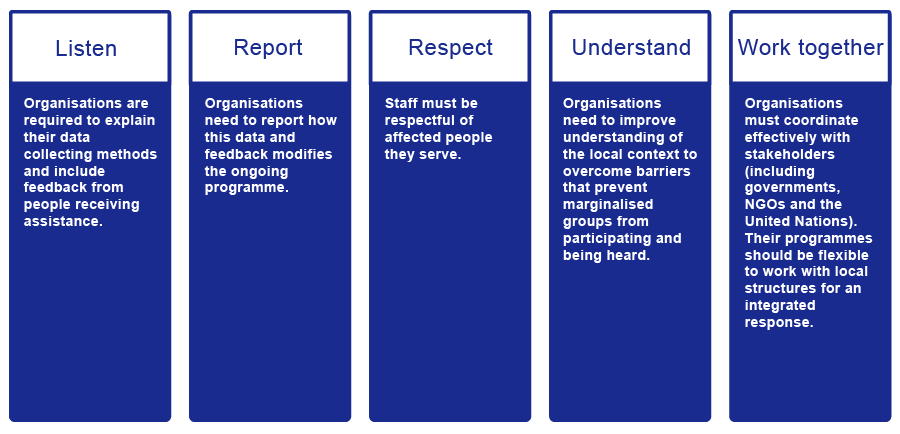This section considers the lessons to be learnt, and what else you should think about when incorporating safeguarding measures.
PRESENTER: Well, good afternoon, everyone. I am Beentou, and I’m going to talk about safeguarding in the Sierra Leonean context within ARISE. Next slide, please.
So, when starting this talk, I’m going to start with our co-researchers because they are so important in the work we do. Co-researcher, our co-researchers are basically community members who are selected from their communities where we work, so aid
us in conducting our research. So, they’re a mix of young and old, men and women, including people living with disabilities. We work together in a partnership. ARISE is so big on partnership and it is not just a word, it is something that we do
every day and that we see. So, these co-researchers are a part of all our trainings that we conduct with our researchers and data collectors. They’re part of us piloting our tools and even analyse our data.
And in our theory of change that was done, we see the beneficial impact of this collaboration clearly outlined there. And even in the reflections our co-researchers give us, they tell us how much they have learnt about the research process. And the
research is not new in their communities, people have been collecting data in their communities for years, but now they see how the data is generated and what’s the answers, how we get the answers we are looking for. So, they are very important
when it comes to safeguarding because no one knows their communities like they do.
So, the UKCDR guidance, their LSTM safeguarding protocols, they were used as a foundation basically upon which we built a more contextualised in-country safeguarding training manual that was done with all in-country partners. So, during the training
we came up with local words meaning safeguarding, we came up with local phrases you can need to ask for help. Because when doing safeguarding, it’s not, it’s important to just not go in thinking that they don’t know anything about safeguarding
even in communities and in countries where it’s new, like Sierra Leone. They get it as long as you explain, and you put it in the local context. They get exactly what you’re trying to say. Next slide, please.
So, when we started, we had safeguarding leads from the partner organisations in the country. But after the training, understanding the different issues and possible barriers to reporting, we trained co-researchers as focal points in their communities
because they are more accessible, obviously, to receive complaints. We live in places where people can’t just send in an email, people can’t just even use the internet all the time and send WhatsApp. So, it’s important that they have this community
focal points to raise concerns with. And our partnership is such that the co-researchers have access to us. So, the safeguarded focal points have access to us, the in-country team.
But they also have access to the LSTM team that is basically the lead, so whatever complaints they want to escalate above us can go straight to the LSTM country support person and can be handled. So, I have worked in different studies, but I noticed
that this is important. This particular relationship is important in ensuring trust in the safeguarding process. Because we all here know that safeguarding issues may arise at any point in the safeguarding chain, so that confidence that we can
report to whoever they want to, and they will receive support is needed.
Then when it comes to the safeguarding team, the ARISE project is such a learning process and after some time we decided that safeguarding leads from all partner countries, Kenya, Bangladesh, India, that we all need a safe space to talk about safeguarding
concerns. So, monthly meetings were set up to discuss, to ask for advice on how to handle certain cases, basically brainstorm as a group on next steps on the reports you receive. So, for example, if you receive an urgent safeguarding incident
that comes up in your country, you can always ask for an emergency safeguarding lead in the team. And this will be set up.
And we even developed a form that is different from the in-country cause for concern forms that we all know that our present in our institutions. Well, this is just a basic form where you can just put down important safeguarding issues that you want
us to discuss as a group. And as much as we are from these countries as, so ARISE made me reflect on my positionality. As much as I’m from Sierra Leone, but my realities are different from the people actually living in these communities. And it
takes a toll as well on us, not only international researchers or researchers from high income countries, that is to be expected, but us local researchers as well.
It makes you recognise your own privilege and the wide disparities in standards of living sometimes within just a few miles from where you live and where you’re working. So, this safe space for me where you can talk to other safeguarding leads in
similar settings in different parts of the world was very important and it’s very important for me. Next slide, please.
And service territories. I have to talk about service directories because they’re important in ensuring a robust safeguarding pathway. The first step is mostly tapping INGO and NGO sources working in these communities to give you a rough guide on
contact details. But also, the co-researchers come in very handy here because the services available in their communities. They are the services people in their community’s use. And we have to check that contact details are up-to-date because
we found out that some numbers you call are not working. So, in my country, for example, it is rare to see a landline in an office or government institution. They’re present in international NGO offices. Everyone uses a mobile phone. Even offices
use a mobile phone.
So, that means they get missing, leadership changes, and so does the phone. So, new phones are bought with new numbers, so cross-checking that the details are up-to-date is important, was important for us, but also is making physical contact with
the services you’ve outlined in the service directory because you may need to have a safeguarding lead for onward referral. So, them knowing that you’re working in their communities, and you’ve discussed your risk register to them and possible
concerns that you may have goes a long way in ensuring that you get prompt aid when needed.
And when it comes to the risk register that Phil already outlined, talking again to the co-researchers allowed us to raise even more risk that you won’t think about like secret societies coming out at particular times of the year with masquerades.
These are things that are community issues that you wouldn’t know as an outsider and these are days in the calendar that you have to, in the community calendar, that you have to avoid. But something, again, that has come up is working in communities
where there are no referral services. What happens when you’re working in these remote communities where there’s nothing? And, at ARISE, we’ve started having these reports from safeguarding leads and you can imagine how distressing this will be.
You’ve trained your co-researchers, you’ve trained your researchers, you’ve trained even the participant on what safeguarding concerns are, but when they have, when they recognise and reports, there’s very little you can do. And what we’re doing we
are now exploring psychological first aid training for our researchers. Because most time you are the first port of call and sometimes, you’re the only one they can report to because you’ve built this rapport with them. And you may be the only
help they may receive, so it is a huge burden.
But at least you are trained to not cause further harm and to respond appropriately to the initial report and, obviously, to come back to the safeguarding leads reporting safe space and just basically detox. The next slide, please.
So, for my final slide, I want to talk about knowing limitations on what we can do. This study also made me realise that working in deprived communities means a lot of things are safeguarding issues. Nearly everything is a safeguarding issue. There
are eviction notices of your participants, there is a fire outbreak, homes are lost to flooding, especially those living in seaside communities. Those houses that are on hillsides may be prone to landslides and mudslides. You would have the young
girls, children of your participants, be married off or initiated into secret societies. So, these are things that may come up.
And it is important to constantly reflect on your safeguarding principles and recognise your limitations, the limitations of the study, what you can do, how much you can do knowing that you are there for a limited time with limited resources and managing
the expectations of communities as well. Because they are seeing us as coming in to help, they’re seeing us as coming in to change their stories, whereas we are there to amplify the stories and link them to stakeholders or services that can help.
And for us having this safe space to talk to other safeguarding leads, again, is crucial for our own mental wellbeing. Last slide, which is just the resources and the references that we used.
Thank you so much for listening.
Watch the video above, in which the presenter shares what lessons were learnt when safeguarding measures were incorporated into the ARISE research project in Sierra Leone.
When collecting data from local communities you should consider everything outlined in the diagram below.
Some of the key points from the video on conducting research are that it presented a bottom-up approach rather than top-down approach by empowering community members to get involved in conducting the research. Community members were involved in contextualising
safeguarding training using local terminology and creating safeguarding systems. The development of a service directory through service mapping is particularly important so that communities know where to go for services when the implementing organisation
isn’t there.
If you want to know more about safeguarding in research, go to the following links:
It sets out four cross-cutting themes and provides questions relating to safeguarding for all involved in the activity. It makes the point that simply laying down a fixed set of requirements is impractical and could potentially reinforce power dynamics.
Instead it promotes posing key questions and generating discussion as a more productive way forward for all involved in the research processes in order to ‘anticipate, mitigate and address potential and actual
harms in the funding, design, delivery and dissemination of research’.
Hasan, a Human Resources Manager based in Amman, has a question about recruitment.
Watch the video above to learn more about Hasan’s question and the response he is given.
Greater diversity and inclusion in your recruitment processes keeps people safe because it fosters trust and accountability. A more diverse and inclusive workforce makes for more effective teams.
![]()



![]()
